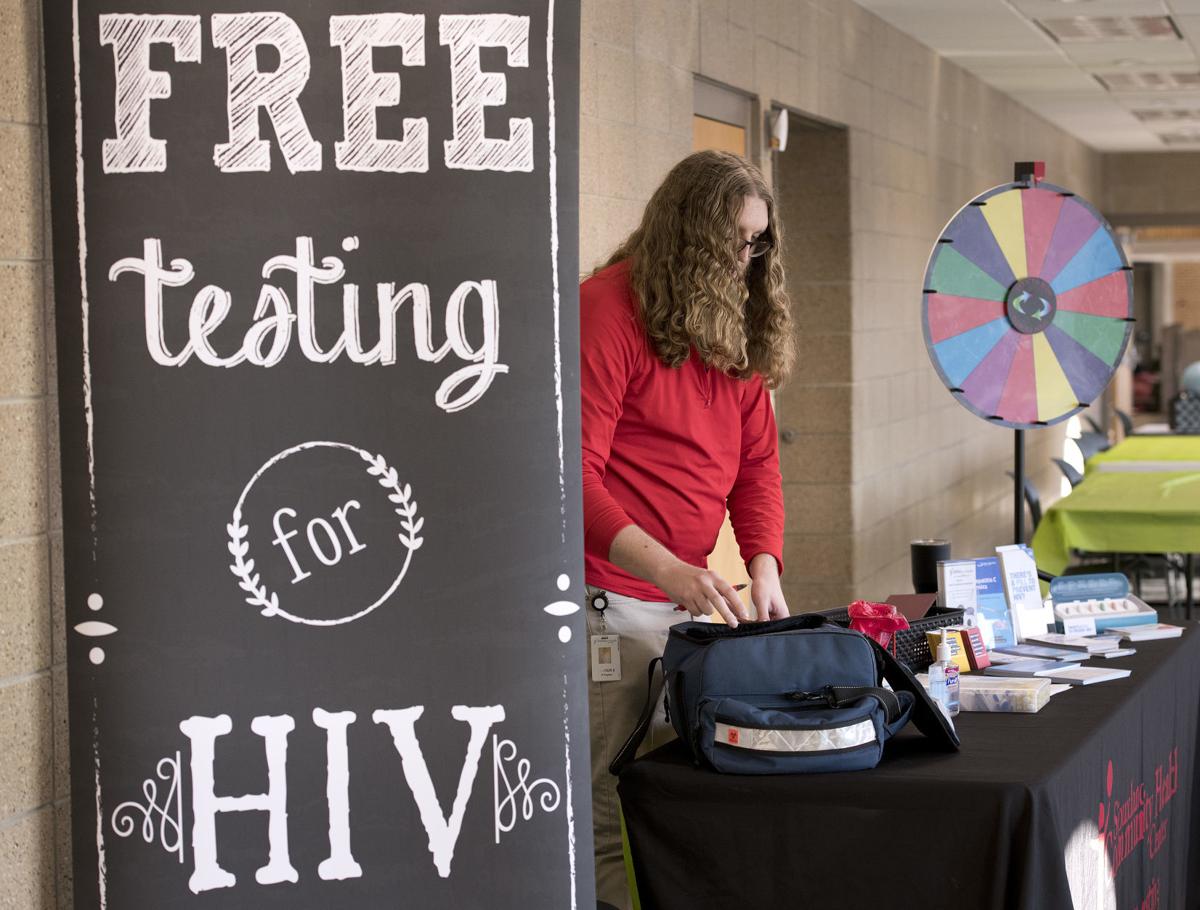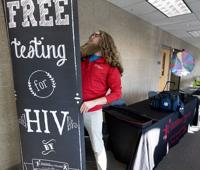Cases of chlamydia, gonorrhea rise sharply in Woodbury County - Sioux City Journal

Carter Smith, an HIV case worker at Siouxland Community Health Center, sets up a booth in an exposition area at the 2019 Be The Change Youth Mental Health Conference held Dec. 18 at Briar Cliff University in Sioux City. Smith was displaying educational materials about HIV and equipment to perform HIV tests. About 250 area high school students attended the conference.

SIOUX CITY -- Local authorities can't say for certain why two sexually transmitted diseases that can pose severe health consequences dramatically spiked in Woodbury County last year. But at least one local health official suspects it's tied to a loss in state funding to prevent STDs.
A total of 343 cases of gonorrhea were recorded in 2018 in the county, up 99 percent from the 172 cases reported in 2017, according to new data from the Iowa Department of Public Health. During that same one-year period, chlamydia jumped 33 percent, from 524 cases to 699.
Chlamydia is the most commonly reported STD in the United States, and it is prevalent among young people, according to the Centers for Disease Control and Prevention. The CDC says an estimated 1 in 20 sexually active young women age 14-24 has chlamydia.
Like chlamydia, syphilis and other STDS, Gonorrhea, a bacterial infection, can cause infertility, ectopic pregnancy and increased HIV risk, if left untreated.
"Gonorrhea always kind of ebbs and flows," said Tyler Brock, Siouxland District Health Department deputy director. "For whatever reason, we are on a high note and it has been significant. It's not just Woodbury County, it's the state of Iowa in general."
The IDPH reports that the number of individuals diagnosed with gonorrhea has more than doubled in the state since 2015, reaching 4,839 known diagnoses in 2018. After a few years of leveling off, preliminary 2019 data indicates that syphilis may also be on the rise in Iowa again.
Woodbury County sees rise in STDs, which follows national trend
The local and statewide surge in STDs mirrors national trends. A CDC report released in October shows that combined cases of gonorrhea, chlamydia and syphilis reached an all-time high in the United States in 2018. Gonorrhea increased 5 percent to more than 580,000 cases, while primary and secondary syphilis, the most infectious stages of syphilis, increased 14 percent to more than 35,000 cases. Those are the highest numbers reported since 1991. Chlamydia increased 3 percent to more than 1.7 million cases, which is the most ever reported to the CDC.
The CDC's annual Sexually Transmitted Disease Surveillance Report indicates that a number of factors could be driving the nationwide increase in STDs, including drug use, poverty and unstable housing, which reduce access to prevention and care. Decreased condom use among vulnerable groups, including young people and gay and bisexual men, and budget cuts to STD programs at the state and local levels are also cited in the report.
Brandi Steck, Siouxland Community Health Center's HIV program manager, said she thinks decreased STD funding is a major factor in the rise of infections in Siouxland.
Planned Parenthood of the Heartland's Sioux City clinic shuttered its doors on June 30, 2017, after Iowa's Republican-controlled legislature approved $3 million in Medicaid funding cuts, which then-Gov. Terry Branstad signed into law before leaving office. Then, last May, Iowa Gov. Kim Reynolds signed the Health and Human Services budget bill, which cut $260,000 from sex education programs provided by Planned Parenthood.
Family planning program enrollment down in wake of Sioux City Planned Parenthood clinic closing
Since the Sioux City Planned Parenthood clinic's closure, Steck said the health center has not only seen an increase in patients seeking services for sexually transmitted infections, but also patients wanting birth control and wellness exams. Through its Title X Family Planning Program, the health center offers a number of sexual health services, including STD testing and treatment, education and counseling for sexual safety, and free condoms.
"We still have patients coming to Siouxland Community Health saying they have not been seen by a provider since Planned Parenthood closed because they did not know where to go for nonjudgmental reproductive health care services," Steck said. "We have been doing marketing and outreach to inform the public of the Title X and preventive health care services we offer."
Steck said patients often feel more comfortable visiting a specialty clinic for STD testing, such as Planned Parenthood, than seeing a primary care provider.

Carter Smith, an HIV case worker at Siouxland Community Health Center, sets up a booth in an exposition area at the 2019 Be The Change Youth Mental Health Conference held Dec. 18 at Briar Cliff University in Sioux City. About 250 area high school students attended the conference.
"When you present to an STD clinic, they assume that you're there for those types of tests," she said. "You go to your primary care physician and they talk about heart disease and diabetes and that kind of stuff. The focus of the conversation isn't around sexual health."
More testing
STD testing has ramped up in Iowa in recent years, which likely accounts for a portion of the increase in positive results, according to Brock, who said advances in technology have allowed for outreach testing to occur in non-traditional settings, including concerts. He said more testing of extragenital sites, such as the throat and rectum, is also occurring.
"We know that we are getting positive cases from those sites, as well," he said.
Gonorrhea cases on the rise in Iowa, Woodbury County
STDs can cause sores, itching, abdominal pain, fever and frequent urination, but a person may not know they are infected for years due to a lack of symptoms.
Antibiotics can cure syphilis, chlamydia and gonorrhea, but gonorrhea has become more difficult to treat as some strains are now resistant to the drugs prescribed.
Today, the CDC recommends a combination of two drugs, ceftriaxone and azithromycin, to treat gonorrhea. Steck said it's important that patients get tested for gonorrhea, get treated if they have it and then return to the clinic to ensure that the treatment was effective.
Chlamydia cases in Siouxland
Look through data of Chlamydia cases diagnosed in Siouxland counties in recent years.
| County | 2014 | 2015 | 2016 | 2017 | 2018 |
|---|---|---|---|---|---|
| Woodbury | 576 | 555 | 623 | 524 | 699 |
| Dakota | 78 | 68 | 115 | 108 | 103 |
| Thurston | 53 | 79 | 82 | 96 | 71 |
| Clay, S.D. | 45 | 67 | 59 | 60 | 70 |
| Sioux | 43 | 54 | 44 | 47 | 68 |
| Plymouth | 52 | 45 | 68 | 52 | 60 |
| Union | 30 | 27 | 22 | 37 | 34 |
| Monona | 26 | 14 | 13 | 20 | 22 |
| Lyon | 11 | 14 | 16 | 10 | 20 |
| Cherokee | 23 | 21 | 28 | 23 | 18 |
| Ida | 16 | * | * | 9 | 12 |
"I would go out on a limb and say there are probably some providers that aren't using the dual therapy and there are probably some providers that aren't doing the check to make sure that the therapy actually worked and that the gonorrhea was cured," she said.
Education varies
Young people between the ages of 15 and 24 account for more than half of all new STD infections that occur in the United States each year, according to the CDC.

Carter Smith, an HIV case worker at Siouxland Community Health Center, sets up a booth in an exposition area at the 2019 Be The Change Youth Mental Health Conference held Dec. 18 at Briar Cliff University in Sioux City. Smith was displaying educational materials about HIV and equipment to perform HIV tests. About 250 area high school students attended the conference.
Steck cited "lack of education" and "poor education among adolescents" as another potential factor in the rise in STD cases.
Twenty-seven states, including Iowa, mandate both sex education and HIV education, according to the Guttmacher Institute, a research and policy organization that seeks to advance sexual and reproductive health. South Dakota and Nebraska do not have such a mandate.
Even in states where sex education is required, the content being taught can vary widely. In Iowa, curriculum decisions are left up to individual school districts.
Gonorrhea cases in Siouxland
Look through data of Chlamydia cases diagnosed in Siouxland counties in recent years.
| County | 2014 | 2015 | 2016 | 2017 | 2018 |
|---|---|---|---|---|---|
| Woodbury | 160 | 164 | 131 | 172 | 343 |
| Dakota | 6 | 11 | 27 | 27 | 41 |
| Thurston | 5 | 13 | 9 | 32 | 24 |
| Plymouth | * | * | * | 15 | 13 |
| Sioux | * | * | * | * | 10 |
| Union | 8 | 5 | 6 | 10 | 7 |
| Clay, S.D. | * | 6 | 13 | 11 | 5 |
The Iowa Code states that each school board must provide "age-appropriate" and "research-based" instruction in human growth and development in grades one through 12 that includes human sexuality, self-esteem, stress management, interpersonal relationships, domestic abuse, HPV and the availability of a vaccine to prevent HPV, as well as acquired immune deficiency syndrome or AIDS. But the law doesn't prohibit a school or school district from offering an abstinence-based or abstinence-only curriculum. Parents or guardians are also allowed to opt their children out of instruction.
In the Sioux City School District, sexual health education is not a standalone curriculum piece, but taught under the umbrella of health.
Jim Vanderloo, director of secondary education for the district, said the district has health teachers in each of its schools with "different expertise." If a teacher cannot address an issue, he said the district may "call in supports from community health or district health" to be guest speakers.
"We start teaching health from K-12. It's nothing that is done in isolation. It's on a continuum through every grade and each grade touches on a little bit of something different and is delivered differently," Vanderloo said.
Health center to pick up patients after Sioux City Planned Parenthood clinic closes
Steck said many area schools used to rely on Title X grantees, which the health center is one of, to teach students "medically accurate, age appropriate, comprehensive sexual health curricula." That changed after President Donald Trump took office in January 2017. Now, clinics that receive funding from the federal grant program have to promote abstinence when invited into schools.
"If they have a Title X educator come into the school system, what they will be presenting to the students is abstinence-only, so that's why it falls mainly on a gym teacher or a health teacher," Steck said. "If you don't feel comfortable talking about this stuff, that information is not going to carry over well to the adolescents."
Carol Garvey, a registered nurse and director of Student Health Services at Morningside College, said sexual health education and STD prevention efforts are ongoing at the private Sioux City college on a daily basis through poster campaigns, tabling events and one on one discussions in the student health center.
Iowa's family planning program use drops 85 percent
"I think knowledge and practice are definitely two different things," Garvey said when asked if she thinks students, who come from around the country and the world, are equipped to make healthy choices when they first set foot on campus. "Some students are in the party mode and choices aren't good."
Although the Sioux City college doesn't provide STD testing on campus, (Students are referred to Siouxland District Health Department), Garvey said she does talk with students in her exam room when they come in for services about the implications of having multiple sexual partners and not being tested for STDs. Garvey said free condoms are available if students need them.
"We try to be proactive and supply what we need for safer sex for those that are having it," she said.
A former Briar Cliff University student was arrested Oct. 24 after the Iowa Division of Criminal Investigation was notified that five males ranging in age from 17 to 19 years old from the Harlan, Iowa, area had been paid with checks to engage in sexual activities with him in his dorm room in the Sioux City college's Alverno Hall.
Earlier this month, Davion Sandifer, 20, of Austin, Texas, pleaded guilty to two counts of forgery, a class D felony, and five counts of criminal transmission of a contagious or infectious disease, which are serious misdemeanors. He faces up to five years in prison for each felony count.
After Sandifer's arrest, Briar Cliff issued a statement that called the allegations "unsettling." The statement also said that policies and protocols are in place to "ensure a safe and secure environment." A spokeswoman for Briar Cliff told The Journal she could not find a representative from the college to talk about STD prevention and education efforts on campus.
Steck said research shows that adolescents whose parents are involved in sex education are more likely to delay becoming sexually active and use condoms when they do eventually have sex. She advises parents to start sexual health education at an early age by talking to their children about appropriate names for their body parts. She said watching TV or looking at magazine covers while waiting in line at the grocery store could turn into a teaching opportunity.
"Some people think you need to sit your child down and have this one big conversation. I think that's awkward for everybody," she said. "I think you need to sprinkle it into a bunch of different conversations over time. You need to start when they're young and continue that conversation throughout their whole lifespan."
Samaritan Hospital

Sioux City's first hospital, Samaritan Hospital, opened in 1884.
Hospital at 28th and Jennings streets

The hospital at 28th and Jennings streets was opened by the Sisters of Mercy in 1890.
St. Joseph Hospital

The first section of St. Joseph Mercy hospital at 21st and Court streets, erected in the fall of 1890 and purchased by the hospital after previous quarters at 28th and Jennings streets proved to be inadequate.
St. Joseph's

St. Joseph's Mercy Hospital was founded by the Sisters of Mercy in 1890. The "Mercy" name would later be conferred to one of Sioux City's present-day hospitals, Mercy Medical Center.
St. John's Hospital

St. John's Hospital was founded in 1908 by Dr. William Jepson, who founded Sioux City's Samaritan Hospital more than 20 years earlier.
St. Vincent Hospital

In the early 1970s, St. Joseph and St. Vincent, a hospital operated by the Benedictine Sisters at 6th and Jennings streets in Sioux City, joined forces to begin the city's first hospital-based ambulance service. Groundbreaking ceremonies were held in 1979 for a new $28 million hospital adjacent to St. Vincent's, the present site of Mercy Medical Center.
Methodist hospital

Methodist and Lutheran hospitals consolidated and formed St. Luke's Hospital in 1966.
Lutheran hospital

Lutheran hospital in Sioux City merged with St. Luke's.
St. Joseph demolition, 1968

Crews from J. Myron Olson begin razing the south portion of the original St. Joseph Mercy Hospital building at 21st Street and Ingleside Avenue.
Health Mercy Air Care

Mercy Air Care is shown in 2010 at its Sioux City helipad. The medical helicopter is based at what was then Mercy Medical Center-Sioux City, now MercyOne Siouxland Medical Center.
Crane moves MRI

Crews position a new MRI machine in the 2800 block of Pierce Street outside St. Luke's Regional Medical Center in 2012.
UnityPoint Health-St. Luke's

UnityPoint Health-St. Luke's hospital came into existence in 1966, with the merger of Sioux City's Lutheran and Methodist hospitals.
Mercy Medical Center - Sioux City

The exterior of Mercy Medical Center--Sioux City is shown.


Comments
Post a Comment